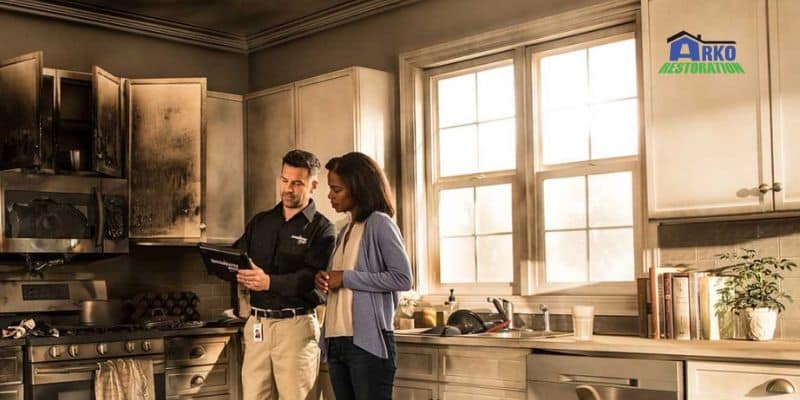Fire takes a heavy toll, regardless of whether it is small or big. After a fire incident, you have to get your life back together, in addition to restoring your properties. During these occurrences, you can get overwhelmed. Nevertheless, knowing what to do and who to call can be very helpful.
What Is Fire Damage Restoration?
Fire damage restoration is the process of assessing property damage from a fire, securing the area, and restoring it to its pre-fire state. It is a part of the larger disaster restoration framework, which may also address weather damage restoration, water damage restoration, and other related issues.
The restoration process comprises removing and repairing structural elements that have been damaged by fire as well as removing any smoke damage that occurred during the fire.

What To Do and Who to Call for Fire Damage Restoration
After a fire incident, the first thing to do is get in touch with the local emergency services to make sure you are safe. You should never go back inside your home until firefighters allow you. A fire can rekindle even if it appears to be out. It is also possible that structural damage made your house unstable.
In case you, your loved ones, or your pets have any injuries, make arrangements for prompt transportation to the closest medical facility or veterinarian. After their needs have been met, get in touch with your loved ones to let them know you are safe and to arrange for temporary housing.
Furthermore, contact your insurance company and hire a fire restoration company to assess the damage after a fire expert allows you. Stay off the property if you are going to try to clean or retrieve items.
How Fire Damage Restoration Professionals Work
Restoring a fire-damaged property is a complex and lengthy process. While fire restoration service professionals may use their unique techniques, most adhere to a standardized procedure. This procedure typically involves the following steps:
1. Damage assessment

In the aftermath of a fire, the path to recovery begins with a thorough assessment of the damage. Once firefighters deem the property safe to enter, professional technicians step in. This evaluation guides the restoration process.
The damage assessment team diligently records all visible fire and smoke damage, including structural integrity issues and the presence of hazardous materials. They also assess the salvageability of various items, determining which can be restored and which must be disposed of.
The primary objective of this assessment is to determine the extent of the damage and establish a plan for restoring the property. The findings are then carefully compiled into a comprehensive restoration plan, ensuring a coordinated and efficient approach to bringing the property back to its original state.
2. Secure the property
After the initial response to a disaster, securing the property is the next critical step in the restoration process. This involves erecting a robust fence around the premises and boarding up the structure. This approach safeguards the property from further damage caused by harsh weather and prevents unauthorized access to the compromised building.
Additionally, if certain sections of the building or structure remain unscathed, the restoration team must seal off the affected areas. This is a strategic containment that limits the spread of damage and also minimizes the risk of cross-contamination.
By carefully isolating the damaged portions, the restoration process becomes more efficient, ensuring that the restoration efforts can proceed with accuracy and effectiveness. This approach to securing and isolating the property lays a solid foundation for the subsequent stages of the restoration project.
3. Preventing further damage
Firefighters make use of a variety of techniques to extinguish flames, with water being the most common. While water effectively puts out most fires, it can also cause water damage. Leaving parts of the building wet can lead to further deterioration from mold, corrosion, and other issues.
Additionally, preventing future damage is the next crucial step in fire restoration. This involves drying out the structure and removing as much water as possible. This process also entails demolition and the removal of severely fire-damaged materials. For instance, technicians remove damaged drywall and flooring during this stage.
4. Clean-up and smoke removal
The cleaning stage of a fire restoration project requires extreme attention to detail and is a labor-intensive process. A committed crew makes sure no surface is left unnoticed as they carefully clear all signs of the fire.
The floors, walls, ceilings, and every corner are carefully cleaned to remove smoke and soot stains, leaving behind a spotless and hygienic atmosphere. This methodical process is necessary to ensure total contamination removal.
Additionally, specialized deodorizers are used after the thorough cleaning to eliminate any residual smoke or fire smells, thereby bringing back a clean, welcoming environment. The crew uses antimicrobial chemicals and disinfectants in situations where water damage has resulted from firefighting efforts to stop the growth of bacteria and mold.
5. Construction and restoration
The last phase of fire restoration involves rebuilding everything that was damaged by the fire. This complex procedure includes rebuilding roofs, fixing damaged walls, and repairing floors. Using specialized techniques to minimize the impact, the restoration team works to salvage and revitalize as much as possible from the aftermath of the fire.
In addition to physical reconstruction, the rebuilding process is a laborious one that requires close attention to structural integrity and safety regulations. Ensuring that the restored elements seamlessly integrate with the overall design and functionality of the property requires close attention to detail.
Additionally, open communication with the restoration team is crucial during this phase. This will enable any necessary adjustments or modifications to be addressed promptly.
Conclusion
Managing fire damage restoration calls for a planned and timely approach. Put safety first, dial emergency services, and hire experts for cleanup and repair. Make quick contact with insurance companies and reliable restoration firms to guarantee a thorough recovery. To minimize damage and rebuild after a fire, time is essential.

